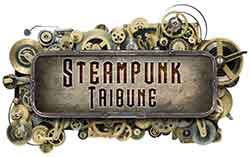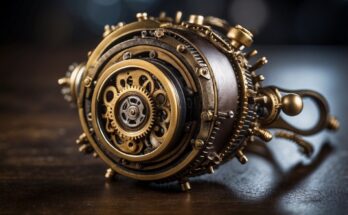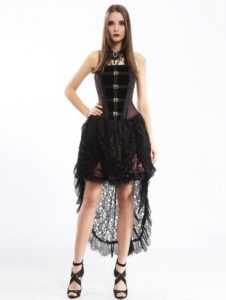Steampunk fashion has undergone significant transformation in recent years, influenced by a blend of creativity, innovation, and cultural revival. What began as a niche subculture inspired by Victorian-era aesthetics and modern technological advancements has expanded into a broader movement encompassing art, literature, and lifestyle. This evolution has seen steampunk fashion merge with contemporary styles, creating new expressions that resonate with diverse audiences.

The integration of DIY ethics and punk influences has played a crucial role in this evolution. Designers and enthusiasts draw from historical elements while incorporating modern materials and techniques, resulting in unique garments and accessories that celebrate individuality. The emphasis on handcrafting and the use of upcycled materials also highlight a growing awareness of sustainability within the fashion community.
As steampunk continues to attract new followers, its fashion scene remains ever-changing. The blend of retro-futurism and personal expression ensures that it stays relevant in contemporary culture. This dynamic interplay encourages a constant reinvention of styles, making steampunk fashion a fascinating reflection of current trends intertwined with rich historical narratives.
Historical Roots of Steampunk Fashion

Steampunk fashion draws heavily from its historical background, with influences rooted in the Victorian era and the Industrial Revolution. The aesthetics of this subculture reflect the rich literary tradition and imaginative landscapes created by pioneering authors.
Victorian and Industrial Revolution Influences
The Victorian era (1837-1901) laid the groundwork for steampunk fashion. Characterized by elaborate designs, high collars, corsets, and rich fabrics, Victorian clothing emphasized social status and decorum.
The Industrial Revolution introduced new materials and production techniques. Innovations like metal, leather, and lace combined to create unique garments. Accessories often included goggles, pocket watches, and mechanical elements, reflecting the era’s fascination with technology and progress.
These styles have been reinterpreted in modern steampunk, blending historical accuracy with fantasy.
Literary Inspirations: From Jules Verne to H.G. Wells
Jules Verne and H.G. Wells significantly influenced the steampunk aesthetics. Verne’s adventurous spirit exemplified the possibilities of science fiction, with works like “Twenty Thousand Leagues Under the Sea” showcasing intricate machinery and exploration.
H.G. Wells expanded on these themes, delving into time travel and social critiques in “The Time Machine” and “The War of the Worlds.” Their narratives shaped the visual and thematic elements of steampunk, inspiring designers to incorporate fantastical gadgets and Victorian aesthetics into fashion.
Readers embraced the melding of adventure, science fiction, and fantasy, which became integral to the steampunk movement.
Evolution of Steampunk Subgenre in Literature and Film
The steampunk subgenre has evolved considerably since its inception. In literature, authors like Bruce Sterling, William Gibson, and K.W. Jeter contributed to the genre’s growth, blending speculative fiction with Victorian elements.
Films and television series have also played a crucial role. Productions like “The Prestige” and “Sky Captain and the World of Tomorrow” depicted lush, retro-futuristic landscapes. These visual representations further cemented the connection between the aesthetic choices in fashion and narrative themes, fostering a vibrant community around the steampunk culture.
As the subgenre expanded, it influenced fashion trends that embraced both creativity and historical references, creating a unique style anchored in its historical roots.
Defining Steampunk Aesthetics

Steampunk fashion embodies a blend of Victorian influences and punk aesthetics, resulting in an eclectic style that emphasizes individuality and creativity. Key elements include distinctive accessories and material choices that reflect both industrial and nostalgic themes.
Key Elements and Iconography
Steampunk aesthetics fuse Victorian fashion with an imaginative twist, marked by a preference for anachronistic designs. Key elements often include top hats, corsets, and waistcoats adorned with intricate detailing.
Iconography plays a crucial role, showcasing gears, cogs, and mechanical motifs. Patterns inspired by machinery are common, reflecting a fascination with the Industrial Revolution. The contrasting color palette typically combines deep browns, muted greens, and metallics, enhancing the retro-futuristic vibe.
The Role of Accessories: Goggles, Corsets, and Cogs
Accessories are essential to defining steampunk aesthetics, with items such as goggles and corsets taking center stage. Goggles serve both a functional and decorative purpose, often embellished with lenses that reflect an adventurous spirit. They symbolize the era’s innovative technological pursuits.
Corsets represent Victorian femininity and craftsmanship. Modern iterations come in various styles, featuring elaborate patterns and materials. Additionally, jewelry often incorporates brass gears and cogs, enhancing outfits while tying in the steampunk theme. Accessories transform basic garments into expressive ensembles.
Material Choices: Leather, Brass, and Lace
Material selection significantly impacts the essence of steampunk fashion. Leather is a staple, used for jackets, vests, and accessories, providing a rugged yet refined look. The texture of leather contributes to the overall industrial aesthetic.
Brass fixtures are often integrated into designs, serving as fasteners or decorative elements. This material not only evokes a sense of nostalgia but also aligns with the industrial theme.
Lace adds a softer touch, often utilized in layers beneath garments or as accents. The interplay of rugged and delicate materials enriches steampunk looks, balancing strength and elegance in a distinctive manner.
Modern Influences and Integration
Steampunk fashion has increasingly drawn from various contemporary influences, merging traditional aesthetics with modern sensibilities. This integration reflects the dynamic nature of fashion today, where boundaries between styles continue to blur.
Influence of Contemporary Subcultures
Contemporary subcultures such as goth, punk, and cyberpunk play a significant role in shaping steampunk fashion. Each brings distinct elements, such as goth’s dark romanticism and punk’s edgy defiance.
Key Features:
- Goth: Incorporates Victorian silhouettes and embellishments.
- Punk: Adds DIY ethos and rebellious attitudes.
- Cyberpunk: Introduces tech-inspired details like LED accessories.
This fusion creates a vibrant, eclectic aesthetic that resonates with a diverse audience. Designers often blend these influences into their collections, producing garments that feel both nostalgic and current.
Cross-Pollination with Goth, Punk, and Cyberpunk Styles
The cross-pollination between steampunk and these styles leads to innovative interpretations. Fashion enthusiasts may mix leather corsets from punk culture with lace and frills typical of goth it enriches the steampunk narrative.
Examples of Integration:
- Leather jackets with brass embellishments.
- Goggles and masks influenced by cyberpunk elements.
- Accessories like chains and spikes enhance the steampunk look.
Fashion events and festivals often showcase this mash-up, where participants blend various aesthetic principles, leading to unique personal expressions of style.
Steampunk in Mainstream Fashion and High Fashion
In recent years, mainstream fashion has adopted steampunk elements, with luxury brands integrating these styles into their collections. Designers like Prada, Chanel, and Jean Paul Gaultier have incorporated steampunk motifs, showcasing them on international runways.
Notable High Fashion Moments:
- John Galliano: His designs often reflect a fantastical Victorian vision.
- Christian Dior: Explores texture and layering reminiscent of steampunk silhouettes.
- Versace: Infuses bold colors and patterns, reflecting steampunk’s adventurous spirit.
These influences indicate a growing acceptance of steampunk within high fashion, bridging artistic creativity with wearable art. This interaction not only elevates steampunk but also ensures its relevance in today’s fashion landscape.
DIY Culture and the Influence of Maker Movements
The rise of DIY culture and maker movements has significantly shaped steampunk fashion. This phenomenon emphasizes customization, creativity, and handmade elements, allowing enthusiasts to express their individuality.
Customization and Handmade Fashion
Customization is a core aspect of contemporary steampunk fashion. Many enthusiasts embrace the DIY spirit, crafting unique pieces that reflect their personal styles. This can include altering existing garments or creating entirely new designs.
Materials often used range from leather to vintage fabrics, highlighting the importance of texture and craftsmanship. Those engaged in DIY often share techniques and tutorials online, fostering a sense of community among makers.
Entrepreneurs in this space frequently sell handmade items, contributing to a vibrant market. The appeal lies in the blend of imagination and skill, resulting in fashion that stands out at conventions and events.
The Growth of Steampunk Conventions and Events
Steampunk conventions, including notable gatherings like SalonCon, showcase the creativity found within the community. Events often feature fashion shows, workshops, and marketplaces where individuals can display their handmade items.
Attendees come together to celebrate creativity and share ideas. This atmosphere encourages collaboration among artists, designers, and fans alike.
Many conventions also host panels focused on DIY techniques, further promoting the maker culture. Such gatherings allow individuals to learn new skills and gain inspiration from the innovative approaches of their peers. The blend of social interaction and craftsmanship makes these events pivotal in the evolution of steampunk fashion.
The Future of Steampunk Fashion
Steampunk fashion is poised for an exciting evolution, driven by emerging trends, a focus on sustainability, and new narratives. The blend of futuristic technology and imaginative designs sets the stage for a vibrant future.
Emerging Trends and Innovations
Innovations in fabric technology play a crucial role in shaping steampunk fashion’s future. Smart textiles are gaining traction, offering options such as temperature regulation or color-changing capabilities. Designers leverage 3D printing to create intricate accessories and components that blend traditional aesthetics with modern methods.
Additionally, augmented reality (AR) could redefine how enthusiasts experience fashion. Virtual try-ons enable individuals to explore diverse steampunk outfits without the need for physical garments. This technological intersection fuels creativity, allowing for a greater variety of styles while enhancing personalization.
Sustainability and the Role of Upcycling
Sustainability is becoming a cornerstone of steampunk fashion. As awareness of environmental issues grows, designers are increasingly focusing on upcycling. This practice involves repurposing vintage materials, which resonates with the steampunk ethos of reimagining the past.
Using reclaimed fabrics and components not only reduces waste but also infuses authenticity into designs. The community is fostering a culture that values artisanship, encouraging makers to source environmentally friendly materials and minimize their carbon footprint.
Potential Paths and Evolving Narratives
Steampunk fashion may see an expansion of its narrative scope. New stories that incorporate themes of futuristic technology alongside traditional elements can engage a broader audience. This evolution can pave the way for steampunk to intersect with other genres, such as cyberpunk or retro-futurism, creating hybrid styles.
Furthermore, as the boundaries of fashion blur with other disciplines, collaborations with tech companies may emerge. Opportunities for interactive garments or immersive fashion experiences can enrich the steampunk narrative, inviting enthusiasts to engage with history through the lens of imagination and innovation.




